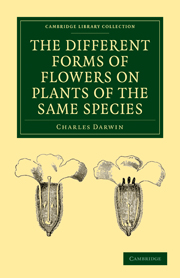Book contents
- Frontmatter
- Contents
- INTRODUCTION
- CHAPTER I HETEROSTYLED DIMORPHIC PLANTS: PRIMTULACEÆ
- CHAPTER II HYBRID PRIMULAS
- CHAPTER III HETEROSTYLED DIMORPHIC PLANTS–continued.
- CHAPTER IV HETEROSTYLED TRIMORPHIC PLANTS
- CHAPTER V ILLEGITIMATE OFFSPRING OF HETEROSTYLED PLANTS
- CHAPTER VI CONCLUDING REMARKS ON HETEROSTYLED PLANTS
- CHAPTER VII POLYGAMOUS, DIŒCTOUS, AND GYNO-DIŒCIOUS PLANTS
- CHAPTER VIII CLEISTOGAMIO FLOWERS
- INDEX
CHAPTER III - HETEROSTYLED DIMORPHIC PLANTS–continued.
Published online by Cambridge University Press: 05 July 2011
- Frontmatter
- Contents
- INTRODUCTION
- CHAPTER I HETEROSTYLED DIMORPHIC PLANTS: PRIMTULACEÆ
- CHAPTER II HYBRID PRIMULAS
- CHAPTER III HETEROSTYLED DIMORPHIC PLANTS–continued.
- CHAPTER IV HETEROSTYLED TRIMORPHIC PLANTS
- CHAPTER V ILLEGITIMATE OFFSPRING OF HETEROSTYLED PLANTS
- CHAPTER VI CONCLUDING REMARKS ON HETEROSTYLED PLANTS
- CHAPTER VII POLYGAMOUS, DIŒCTOUS, AND GYNO-DIŒCIOUS PLANTS
- CHAPTER VIII CLEISTOGAMIO FLOWERS
- INDEX
Summary
It has long been known that several species of Linum present two forms, and having observed this fact in L. flavum more than thirty years ago, I was led, after ascertaining the nature of heterostylism in Primula, to examine the first species of Linum which I met with, namely, the beautiful L. grandiflorum. This plant exists under two forms, occurring in about equal numbers, which differ little in structure, but greatly in function. The foliage, corolla, stamens, and pollen-grains (the latter examined both distended with water and dry) are alike in the two forms (Fig. 4). The difference is confined to the pistil; in the shortstyled form the styles and the stigmas are only about half the length of those in the long-styled. A more important distinction is, that the five stigmas in the short-styled form diverge greatly from one another and pass out between the filaments of the stamens, and thus lie within the tube of the corolla. In the long-styled form the elongated stigmas stand nearly upright, and alternate with the anthers. In this latter form the length of the stigmas varies considerably, their upper extremities projecting even a little above the anthers, or reaching up only to about their middle. Nevertheless, there is never the slightest difficulty in distinguishing between the two forms; for, besides the diiference in the divergence of the stigmas, those of the short-styled form never reach even to the bases of the anthers.
- Type
- Chapter
- Information
- The Different Forms of Flowers on Plants of the Same Species , pp. 81 - 136Publisher: Cambridge University PressPrint publication year: 2010First published in: 1877



